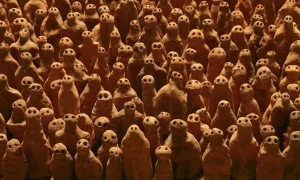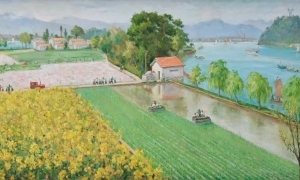朱兵将绘画作为了解自己和认识周围世界的一种方式,而不是一种职业或放松身心的爱好。
可能正是出于这个原因,绘画的过程变得非常重要,其重要性甚至可能超过作品本身。这个过程包括作品的构思、准备和执行。有时候,艺术家会有一个明确的方向,迅速完成整个过程;但有时候,这个过程会漫长而复杂,艺术家则会疑惑重重,不断改变主意。通过长期直面白色的画布,面对这种我们都觉得有些害怕的“空白”,朱兵重新审视着自己充满“拴住梦想的回忆”的生活。(引自阿根廷作曲家卡洛斯•加德尔Carlos Gardel的杰作《回归Volver》)。这些回忆时而会有力的左右艺术家现在的生活,时而则会让他怀旧而伤怀。
“未来”仅仅存在于我们的思想、希望和恐惧之中。但是,未来能够极大的影响我们,有时候甚至会把我们打击的直不起腰来。如果我们仔细观察就会发现,“过去”是否真的存在也是一个未知数。在禅宗思想里,我们每一天都会重生。每时每刻,我们都可以下决心变成一个全新的、不同的人。但是我们仍会背负着无数经历的“印记”,这些经历造就了我们,也为我们指引方向。但是,就算我们逐渐熟悉了那些影响我们生活的元素,或者更加了解了那些我们孩提时代就存在的“鬼魂”,我们还是无法开启生命的新篇章。我们必须面对的“空白”包含了我们过去存在的一些重要碎片:这可能也是为什么我们愈加觉得难以面对这种空白。
如今,很多人把绘画当成一种技艺或是一种符号化语言,需要长时间的学习;画家应该遵守各种规则和比例的要求,处理好颜色和色调之间的关系。但是,如果我们如此理解绘画,它就失去了更深层次的、本质的特性,而这一点中国的文人相当了解:他们用绘画来表达那些打动自己的重要真相,这群志趣相同的人之间存在着一种“选择性亲密”(elective affinities)。如果我们把绘画当成一种技艺,它就会成为一种装饰性或商业性的活计,绘画的目的以及绘画本身就不会呈现出任何新的东西——绘画就会沦为彩色的污渍或是视觉叙事。
在我和朱兵接触的这几年中,我一直觉得他是个专注的人,也是个坐不住的人。他对于自己和绘画的关系要求很高。他身处的当代艺术大环境和自己格格不入,因为现在艺术家所谓的成功取决于一些十分平庸的具体标准。但是,我看到他经常在考虑有没有必要手拿画笔呆在画室里好几个小时。我听到他问自己的一些问题超越了大众关心的表面而肤浅的话题。他会去真诚而认真的思索自己艺术追求的意义。我认为他的艺术生涯和自己的生活紧紧相连,这一点可以从他的出生地河南谈起。
我有几次有幸在河南和朱兵呆了不少天。我去他那里是为了追寻他画作中的那些风景和回忆。
黄河沿岸
朱兵出生和长大的地方在郑州和开封之间,处于城市和郊区的结合部位;那里有着悠久的历史,也留存着逝去时光的碎片。他自身的节奏和黄河这条大河一样缓慢,而黄河沿岸的风景特征明显:平整的土地、突兀的峡谷和冷漠的布满细沙的沟壑交替出现。他记忆中的树木单薄而细长,看起来有些骨瘦如柴。这些树木成长的地区通常雨水不足,冬季寒冷,夏季酷热。朱兵对于树的认识说明了他是城市居民:他对这些树有种熟悉的感觉,但并不知道它们的学名或是用途。不过,树木是他画作中的绝对主角。
在他举家从河南的红土地上搬到广东后,他被那里的植物所吸引。他吃惊的发现,广东的草木多为常绿物种,长得枝繁叶茂,几乎无处不在。在中国这样的国家里,由于城市之间基本上没什么区别,气候和植被的差别成了抵御视觉“全球化”的唯一壁垒。
我觉得朱兵对于树木的热情和他的朋友兼同行孟煌对于树木的感情不同,也和画家段建宇(郑州人,在广州住了不少时间)的感觉有别。段建宇作品中的树很容易辨认:画中有竹子和冷杉等树种,看起来像是画家参照了植物学手册,然后用相当讽刺、风趣且玩世不恭的方式表现了出来。孟煌作品中的树则是不断生长和运动的活物,就像是伸向天空的手。而朱兵画的树是由久已散佚的回忆和相对年轻的记忆生成;它们让人想起某些气氛和心境,同时也在质疑观者。
“为什么画树?”朱兵问自己。“这跟北方有关系:每当想起河南的时候,我总会想到冬天的树林;是冷的气氛感动了我,是树枝扭曲的形状打动了我;扭曲的形状也让我想起了中国画常见的树的主题。”
让艺术家回想自己成长的地方似乎会影响他的“现在”;可能回忆这个过程本身让他过去的经历显得不那么艰辛,让它们变得有些亲切,使人欣慰。
或者说,朱兵经常生活在“过去”,因为“现在”看起来太过乏味、舒适和平常。简言之,它缺乏那种数代中国人都十分熟悉的近乎英雄般的牺牲的感觉。通过和一些同龄人、比我大一些的同辈(五六十年代出生的人)以及一些后辈聊他们的童年,我了解到他们最深刻的记忆也是最感人、最寻常的记忆都是“缺少”某件东西的记忆:物质的缺乏带来了各种奇思妙想和天马行空的创意。
我想大家都觉得容易到手的东西都容易被忘却,之后也不会留下任何痕迹。而自己努力赢到的东西则体现了个人艰苦奋斗的结果,会带来内在的成长。朱兵年轻的时候在一家工厂干活,工作累的想要撒手不干。但是,他的年轻岁月中也有许多快乐,这些简单的记忆让他印象深刻。比如:他十几岁的时候和一群朋友逃课,躲到乡下,像大人一样烤食物和抽烟。再比如:他与工厂的关系也很特别,这里是他学工的地方,也是他受苦和受累的地方。
梦境的风景
我认为,朱兵过去几年创造的作品表明他一直在做减法。他早期作品中的风景里充满了玩偶、人偶和动物等各种东西,而现在它们逐渐被一种种氛围所替代。这些氛围也带有相同的神秘感,而不再需要那些过分直白,有时候有些古怪的事物的衬托。他的用色变得“满是灰尘”,作品轮廓不清,人物融在一起,看起来几乎无法分辨。朱兵喜欢用土色,比如黄棕色(sienna)和红棕色(burnt sienna)。(这里两个表示颜色的英文词不是来自河南泥土的颜色,而是来自意大利“锡耶纳Siena”城的泥土颜色。这一点看起来挺怪,不过从单词的历史来看,表达这个颜色的单词来自意大利语。)艺术家很少用鲜明的纯色:他用的颜色都是自己调配的独特颜色,无法复制。
猫是朱兵最钟爱的动物,也是最神秘的动物:他经常在作品中描绘猫科动物,可能是一群,也可能是一只;它们的轮廓在画面背景的衬托下十分鲜明,有时候它们也会和其它东西融在一起。除了他画作中常常描绘鸟类之外,他希望通过这些猫科动物表达一种神秘和迷茫——它们的尺寸有时候和风景不成比例,这也凸显了它们的神秘。
朱兵作品中的一些背景让我们想到了城市中常见的小公园:小桥、木制或水泥的亭子和巨大的蘑菇般的雨伞。看上去在这些地方什么事情都可能发生,就好像有一个迷迷糊糊、闷闷不乐的爱丽斯刚从奇境回来,小心翼翼的穿过一条条道路,经历一次次奇幻之旅。
朱兵作品中另外一些背景包括肮脏的城乡结合部,画中我们能看见飘满垃圾的小溪。虽然人类对这些地方造成了巨大的破坏,但我们还是可以看到自然神奇的创造力。
我个人最喜欢的作品是那些剥离了各种符号或是易于辨认的各种形象的作品(参见前文的介绍),我偏爱画家直接将一种状态转变成绘画本身的做法,他把这种状态变为笔触和油彩,让它们成为一种几乎无法分辨的整体;从长期来看,这种处理手法可能会发展成为纯粹的抽象风格。
但是,朱兵最近告诉我,他对于讲述一个完整的故事更加感兴趣;他希望作品中有叙事的发展和结局:如果他想要表现时间的跨度,最合适的就是采用影像等能够捕捉动态的媒介。因此现在他对这些媒介非常感兴趣。
他有一件大尺寸作品由数张画纸并置而成,是他朝这个美学方向发展的第一步。我相信他未来肯定还会有自我的、尚难预测的发展。他已经不再去过分担心颜色的使用,这是一个很现实的问题,而是将精力集中在叙事中,仅仅采用石墨色的背景和笔触。这里浮现出艺术家进一步表达自己的欲望,通过使用可以辨认的元素描绘集体的想象;因此,他开始更加关注外部世界,而不是自己的内心世界。人类和动物形象一同出现在他的画布上,比例和透视都被颠覆。这些形象让我们想起了卡通的风格,当然它们也带有我们熟悉的悬疑和神秘的感觉。
我相信,艺术家的创作历程会引导他尝试新的艺术语言和理念,让他的作品在彰显自我特性的同时,更加易于他人理解。
莫妮卡•德玛黛(Monica Demattè)
2009年10月8日作于洛阳
翻译:黄一
NOSTALGIA FOR THE FUTURE
For Zhu Bing painting constitutes a way to know oneself and one's surrounding reality, rather than a profession or a relaxing hobby.
It is perhaps for this reason that the process of painting, which includes a work's conception, preparation, and execution, which are at times quick and determined, at others long, complex, and ridden with doubt and changes of heart, holds an importance which is perhaps greater than the final result. Through his continuous confrontations with the whiteness of the canvas, with an “emptiness” that - more or less - terrifies us all, Zhu Bing re-examines his life, which is full of “memories that chain dreams” (as in the lyrics of “Volver” [returning] - a beautiful song by the Argentinian songwriter Carlos Gardel) and which influence the artist's present life in sometimes pressing terms, while at other times tinging it with a yearning nostalgia.
The future exists but in our thoughts, hopes and fears, yet, despite this, it can affect us in powerful, sometimes castrating ways. Upon a closer look, the past's actual existence is just as uncertain. According to Zen thought, each of us is born anew every day, in each moment one may decide to become a new, different person. Yet we bear the “marks” of countless experiences, which forge and direct us. Not even our progressive awareness of the elements that have influenced our lives, of the ghosts that we may trace back to our childhoods, can allow us to be open to new chapters in our lives. The “emptiness” we must confront also bears certain profound vestiges of our prior existences: perhaps that's what renders it even more difficult to face.
Painting is now often considered as a technique, a codified language that stems from long hours of study and the observance of rules, proportions and the relationship between colors and tones. In this way it is stripped of its deeper, foundational significance, which Chinese literati knew so well: that of expressing and communicating profound truths that resoundingly strike the collective chords of those kindred spirits who share “elective affinities”. Thus reduced to a purely decorative or commercial function, the object of painting, the painting itself, does not unveil anything new – it is but a colorful stain or a visual narrative.
During my encounters with Zhu Bing through the years, I have always found him to be intent, restless, and demanding with regard to his relationship with painting. Although immersed, despite himself, in an environment – that of contemporary art – that gauges success according to highly prosaic, concrete criteria, I have seen him constantly question the sense of spending long hours in his studio, brushstroke in hand. I've heard him ask himself questions that go beyond the external, superficial marks of public recognition, instead honestly and rigorously questioning himself about the meaning of his artistic endeavors. I believe his is an autobiographical course, which began in the place of his birth, Henan.
It is precisely in Henan that I chose to spend several days with the artist on a number of occasions, in pursuit of the landscapes and recollections that fill his works.
Along the Yellow River
Zhu Bing was born and raised between Zhengzhou and Kaifeng, between the city and immediate suburbs of places with a rich history that bear the vestiges of bygone days. He carries within himself the slow rhythms of the great river, the distinct landscapes that alternate flat, regular areas with sudden gorges and impervious, crumbly-soiled ravines. The trees he remembers are thin, slender, and rather scrawny, as are those that grow where rain is scarce, winters cold, and summers hot. Zhu Bing's knowledge of trees is that of an urban dweller, who carries within himself a sense of familiarity for them, rather than a knowledge of their names or possible uses. Yet trees are the absolute protagonists of his paintings.
When he moved with his family from Henan, the land of red soil, to Guangdong, with its lush, evergreen, invasive and imposing vegetation, it was precisely this feature that struck and attracted him. In a country such as China, where each city alas resembles all the rest, variations in climate and vegetation constitute a barrier to visual “globalization.”
I think Zhu Bing's passion for trees differs from the likewise as intense one of his friend and colleague Meng Huang, as from that of his colleague, the painter Duan Jianyu, a native of Zhengzhou who has been living in Guangzhou for a few years. Her trees are all easily recognizable: bamboo, firs, and the like, which seem to have been derived from a botanical manual and reproduced in a rather ironic, breezy, irreverent vein. Meng Huang's trees are living matter in a state of perpetual growth and motion, like hands stretching towards the sky. Zhu Bing's trees are instead engendered by both long-lost and more recent recollections; they evoke certain atmospheres and states of mind while questioning the viewer.
“Why paint trees?” Zhu Bing asks himself. “It has to do with the north: each time I think of Henan, the woods in winter come to mind, and that sense of feeling cold that moves me. It's the shape of the naked branches that tightens the throat and makes me think of trees and how they so often appear in traditional Chinese painting.”
Conjuring up the places where the artist grew up seems to overwhelm the present; perhaps the process of remembering softens the hard nature of his past experiences, lending them a tender, comforting air.
Or perhaps Zhu Bing often lives in the past because the current situation seems overly humdrum, comfortable, and ordinary; in short, it lacks that almost heroic sense of sacrifice that scores of Chinese generations know so well. From my conversations about the childhoods of both my contemporaries and slightly older peers (born in the fifties and sixties) – or even younger – I have come to realize that the sharpest memories, which are also the most moving and commonly shared, regard the “lack” of something: material lacks that have in turn led to the development of ideas, flights of fancy, and creativity.
I think it is true that for each of us things that are acquired too easily are just as easily forgotten, leaving no marked traces in their wake. Instead, every personal conquest is the fruit of arduous, impervious, hard-fought personal paths that lead to inner growth. Zhu Bing's youth, which was also spent toiling in a factory which taxed him to the point of making him quit, nonetheless holds within it the glowing glimmer of joys as simple as they are intense. Such as the time when, as a teenager, he skipped school with a group of friends to go on a trip to the countryside, where they all barbequed some food and smoked like grown-ups. Or the artist's relationship with his factory, a place of human apprenticeship, but also of suffering and strenuous effort.
Landscapes as Dreams
The artist's paintings during the last few years I think show that Zhu Bing has adhered to an important, significant process of subtraction. The items that crowded his landscapes a few years ago – dolls, human figures, animals - have gradually been replaced by atmospheres which alone contain the same sense of mystery without the need for overly explicit, sometimes exotic, elements. The colors have become “dustier,” the contours hazy, and the figures dissolve into each other, becoming almost undifferentiated matter. Zhu Bing favors earth tones, such as sienna or burnt sienna (it seems strange to speak of colors whose name derives from the earth of “Siena” rather than Henan's, but historically that color's name bears Italian roots...). Sharp, pure colors and tones rarely appear: for the most part the colors the artist uses are unique blends that cannot be reproduced.
Cats are the artist's most beloved animal, and the most mysterious; he often depicts feline figures, whether in groups or singly, whose profiles are sharply delineated with respect to the background, or whose figures blend in with the matter depicted. Along with birds, which are also a familiar subject, these felines are meant to exalt a sense of mystery and disorientation – their size, which is sometimes disproportionate with respect to the landscape, only serves to underscore their arcane nature.
A few settings remind us of the small parks that are so often found in the cities: small bridges, wooden or cement pavilions, and huge mushroom-like umbrellas. It seems that anything could happen there, that a dreamy, rather gloomy Alice has just returned from Wonderland and is thoughtfully picking her way through one path or another, one amusement ride or another.
Other settings include squalid urban outskirts bordering fields with debris-swollen brooks, which, despite the havoc humans have wreaked, still bear traces of the creative, enchanting force of nature.
Personally, the paintings I like best are those in which, as I mentioned above, the painter does without symbols or easily recognizable figures, and instead directly transforms a given state of being into the act of painting itself, into brushstrokes and drippings that are immersed in an almost undifferentiated whole that could, in the long run, lead to pure abstraction.
Yet Zhu Bing has recently confessed to me that he is more interested in telling a complete story, with a narrative development and an ending: the scanning of time, which is better expressed through media that capture motion, such as video, greatly interests him.
His large drawings, made up of several sheets of juxtaposed paper, are but the first step in this aesthetic direction, which I think will be marked by original, unpredictable developments. Having freed himself from the concerns which, whether one likes it or not, the use of color entails, the artist may now wholly devote his efforts to the telling of a narrative through the use of graphite backgrounds and strokes. Here a further aspect of the painter's expressive needs emerges, that of drawing upon a collective imagination through the use of recognizable elements, hence addressing the outer realm more than his own inner realm. Human and animal figures share a space in which proportions are subverted and thus perspective as well. They remind us of the language of cartoons, despite their also bearing that sense of suspension and mystery we've come to know so well.
I am convinced that the artist's creative course will lead him to experiment with new languages and artistic visions, which, while increasingly reflecting his own nature, will nonetheless become ever more accessible to others.
Monica Demattè
Luoyang, 8 October 2009
Translation by Francesco Giusti
【编辑:霍春常】





















